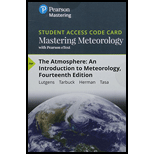
The way in which tilt of the Earth on its axis causes seasons.
Answer to Problem 1RQ
Inclination of the axis is the primary cause of the seasons. The orientation of the Earth to the Sun changes continuously when it travels along its orbit, and it results in a seasonal variation. The axis of the Earth is not perpendicular to the plane of its orbit around the Sun. Instead, it is tilted
Explanation of Solution
A major factor that causes seasons is the gradual change in the angle or altitude of the Sun above the horizon. The amount of energy that is received at the surface of the Earth is influenced in two ways by the seasonal variation in the angle of the Sun above the horizon. Primarily, the solar rays became the most concentrated and thereby most intense when the Sun is directly overhead. When the angles are less, they spread out and the intensity of solar radiation that reaches the surface becomes less.
In addition, the path that is taken by the rays of the Sun when they pass through the atmosphere depends on the angle of the Sun. When the position of the Sun is directly overhead, then the solar rays strike the atmosphere at an angle of 90 degree, and it travels to the shortest possible route to the surface. However, to reach the surface, the rays that enter at a 30-degree angle should travel twice of this distance, whereas the rays that have a 5-degree angle is able to travel through a distance that approximately equals the thickness of 11 atmospheres. When the length of path is longer, then the chance for sunlight to disperse by the atmosphere is higher, and it reduces the intensity at the surface.
Want to see more full solutions like this?
Chapter 2 Solutions
Mastering Meteorology with Pearson eText -- Standalone Access Card -- for The Atmosphere: An Introduction to Meteorology (14th Edition) (MasteringMeteorology Series)
 Applications and Investigations in Earth Science ...Earth ScienceISBN:9780134746241Author:Edward J. Tarbuck, Frederick K. Lutgens, Dennis G. TasaPublisher:PEARSON
Applications and Investigations in Earth Science ...Earth ScienceISBN:9780134746241Author:Edward J. Tarbuck, Frederick K. Lutgens, Dennis G. TasaPublisher:PEARSON Exercises for Weather & Climate (9th Edition)Earth ScienceISBN:9780134041360Author:Greg CarbonePublisher:PEARSON
Exercises for Weather & Climate (9th Edition)Earth ScienceISBN:9780134041360Author:Greg CarbonePublisher:PEARSON Environmental ScienceEarth ScienceISBN:9781260153125Author:William P Cunningham Prof., Mary Ann Cunningham ProfessorPublisher:McGraw-Hill Education
Environmental ScienceEarth ScienceISBN:9781260153125Author:William P Cunningham Prof., Mary Ann Cunningham ProfessorPublisher:McGraw-Hill Education Earth Science (15th Edition)Earth ScienceISBN:9780134543536Author:Edward J. Tarbuck, Frederick K. Lutgens, Dennis G. TasaPublisher:PEARSON
Earth Science (15th Edition)Earth ScienceISBN:9780134543536Author:Edward J. Tarbuck, Frederick K. Lutgens, Dennis G. TasaPublisher:PEARSON Environmental Science (MindTap Course List)Earth ScienceISBN:9781337569613Author:G. Tyler Miller, Scott SpoolmanPublisher:Cengage Learning
Environmental Science (MindTap Course List)Earth ScienceISBN:9781337569613Author:G. Tyler Miller, Scott SpoolmanPublisher:Cengage Learning Physical GeologyEarth ScienceISBN:9781259916823Author:Plummer, Charles C., CARLSON, Diane H., Hammersley, LisaPublisher:Mcgraw-hill Education,
Physical GeologyEarth ScienceISBN:9781259916823Author:Plummer, Charles C., CARLSON, Diane H., Hammersley, LisaPublisher:Mcgraw-hill Education,





